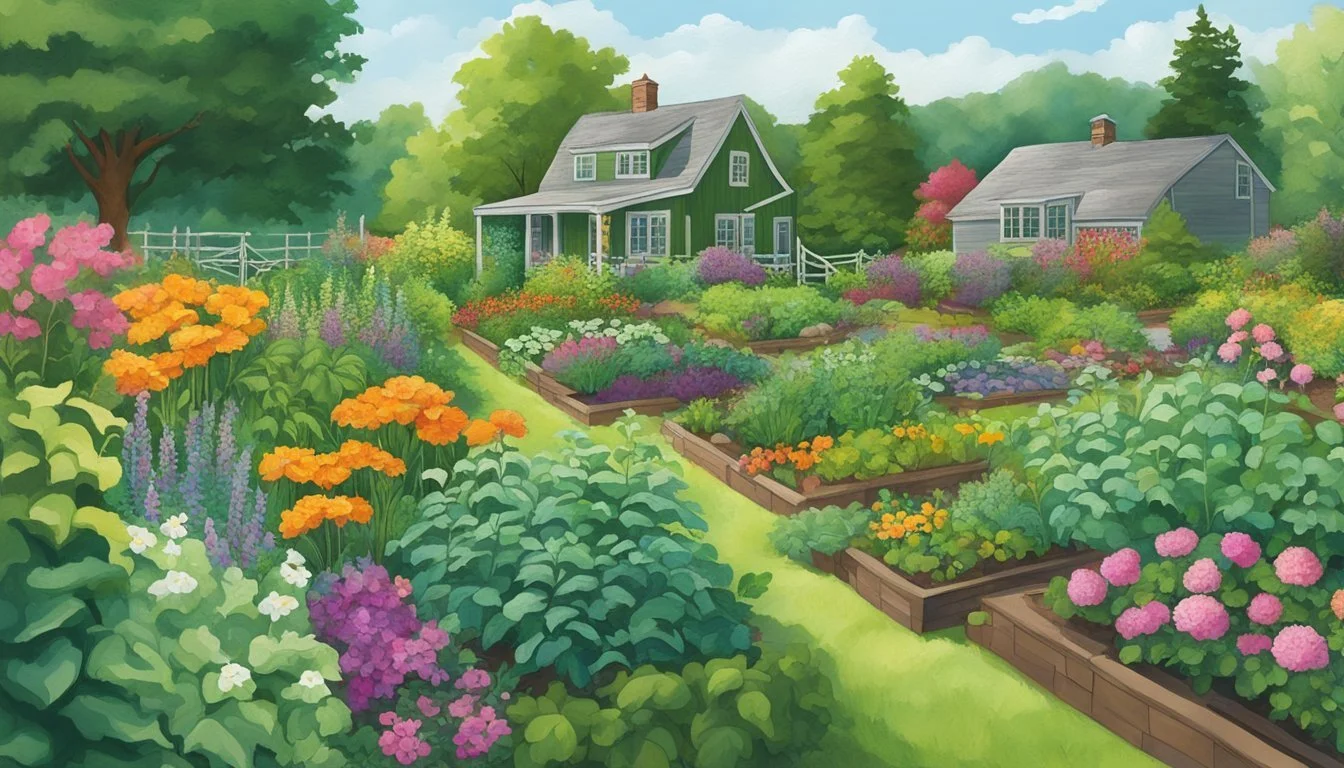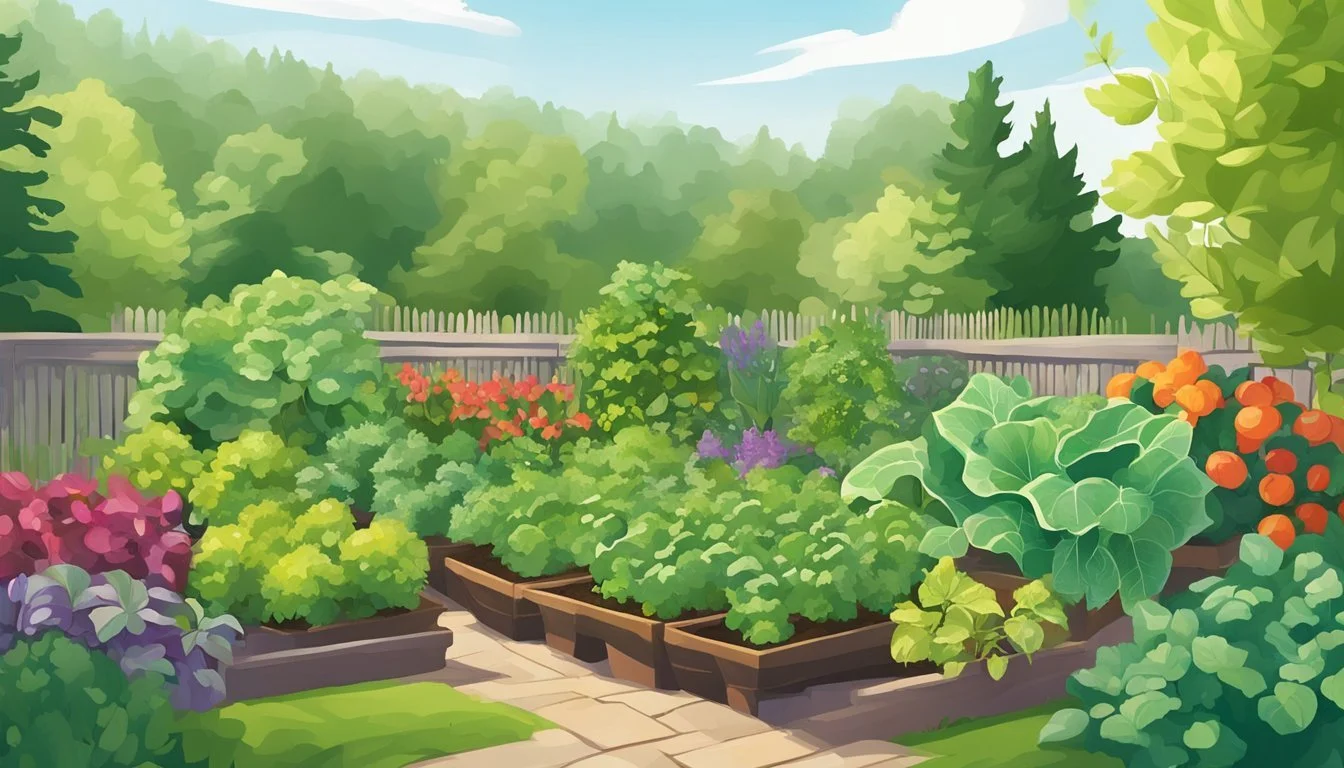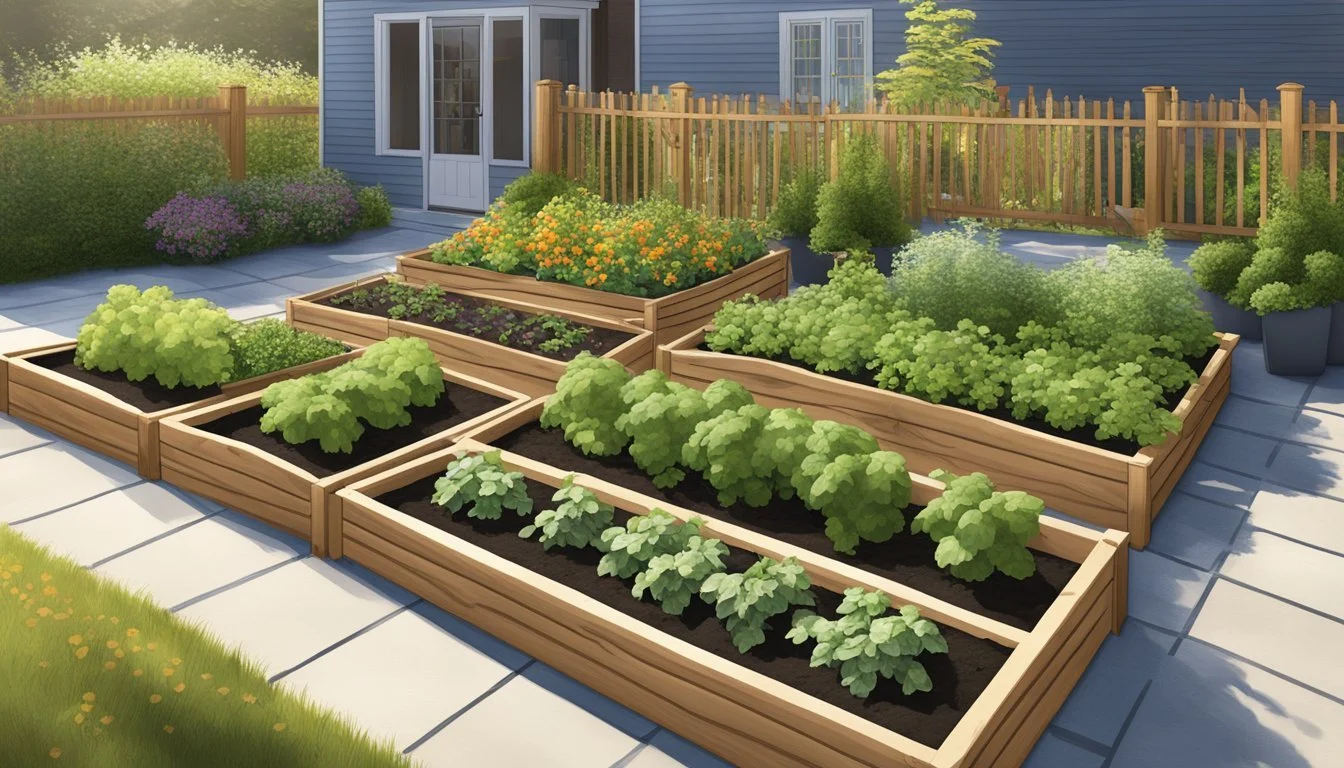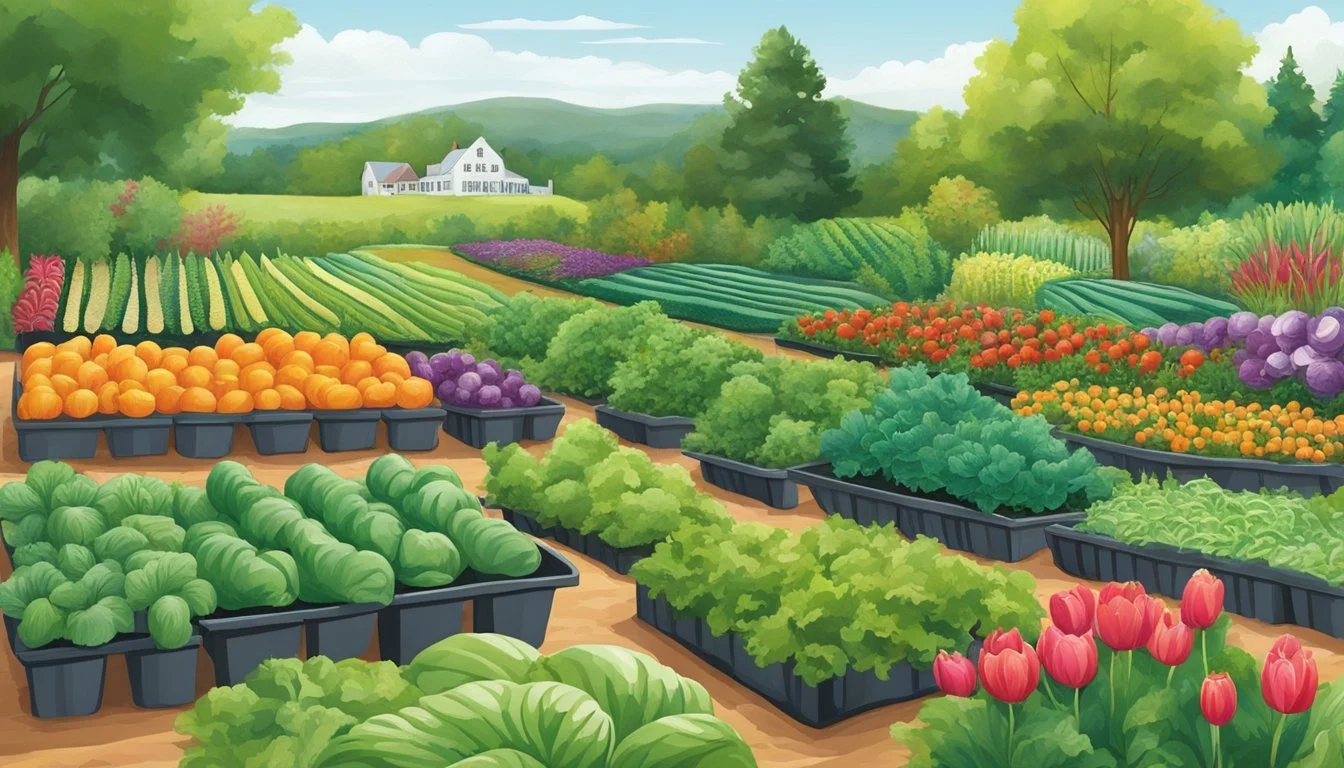Vegetable Gardening in New Hampshire
A Guide to Cultivating Success
This Article is Part of Our Guide on Vegetable Gardening by State
Vegetable gardening in New Hampshire offers a unique opportunity to cultivate a variety of plants that thrive in the state's variable climate. With its cold springs and cooler fall months, the region is particularly well-suited for growing cold-hardy vegetables. Gardeners in New Hampshire often begin their season with vegetables like lettuce, which can tolerate frost and even light snow. The practice of vegetable gardening here requires an understanding of the local weather patterns, including recognizing the last frost date to protect sensitive plants and ensure a successful harvest.
The selection of vegetables that grow in New Hampshire's climate extends beyond just early spring varieties. Leafy greens such as spinach and kale, along with cruciferous vegetables like broccoli, cauliflower, and cabbage, are also quite adaptable to the cooler temperatures found in this region. Root vegetables, peas, and beans are other robust choices for New Hampshire gardens, capable of flourishing in the state's soil conditions. A strategic approach to planting times and maintenance is essential, incorporating both the right vegetables and the right care techniques, to foster a fruitful vegetable garden.
New Hampshire gardeners must also consider the timing of their plantings. Understanding when to start seeds (how long do seeds last?) and when to transplant young plants outdoors is critical, as is knowing which vegetables to plant during each part of the growing season. For example, Memorial Day is often used as a benchmark for planting frost-sensitive vegetables in central New Hampshire. Through careful planning and by selecting appropriate vegetable varieties, residents can enjoy bountiful gardens that yield fresh produce from early spring through the last days of fall.
Understanding New Hampshire's Climate
New Hampshire's varied climate significantly influences vegetable gardening, with hardiness zones and seasonal weather patterns determining what and when to plant. Below, key considerations are outlined to help gardeners plan accordingly.
Identifying Your Hardiness Zone
The state of New Hampshire spans several USDA Hardiness Zones, ranging from zone 3 to zone 6. These zones are crucial for determining the types of vegetables that can thrive in a particular region. Here is a breakdown of New Hampshire's zones:
Zone 3: Found in the northernmost areas, with short growing seasons.
Zone 4: Covers the White Mountains area, allowing for a variety of cold-tolerant crops.
Zone 5: Encompasses central New Hampshire, suitable for a wider range of vegetables.
Zone 6: Located in southern New Hampshire, where slightly warmer conditions prevail.
Last Frost Date and Growing Season
Understanding the last frost date is vital for timing the planting of vegetables in New Hampshire. The growing season begins after the last spring frost, which can vary significantly across the state:
Zone 3: Last frost dates can extend into late May or even June.
Zone 4 and 5: Spring frosts typically end in mid to late May.
Zone 6: Frost generally ceases early May.
Planting before the last frost date risks damage to cold-sensitive vegetables. The duration of the growing season also varies by zone, with southern areas enjoying a longer season conducive to a more diverse crop selection.
Summer Heat and Drought Challenges
While New Hampshire is known for its cold winters, summer brings its own set of challenges. Periods of heat and drought can impact vegetable gardens, particularly in the typically hotter and drier zone 6. Provisioning for these conditions is essential:
Heat: Adequate mulching and regular watering can help vegetables cope with high temperatures.
Drought: Efficient water management practices, such as drip irrigation or rainwater collection, become indispensable during dry spells.
Gardeners in New Hampshire must remain vigilant and adaptive to the climate's fluctuations to ensure a successful and bountiful vegetable garden.
Preparing the Garden Space
Proper preparation of the garden space is crucial for a successful vegetable garden in New Hampshire. It involves carefully choosing the location with enough sunlight, enhancing the soil for optimal growth, and thoughtfully designing the layout of the garden for ease and productivity.
Choosing the Right Location
A garden must receive a minimum of 8 hours of direct sunlight per day for most vegetables to thrive. It's important to observe the yard throughout the day to identify the sunniest spot. Areas with partial shade can be utilized for growing herbs and leafy greens like lettuce and spinach, which are more shade-tolerant.
Avoid low-lying areas since they can lead to poor drainage and potential frost pockets. For gardeners with limited space, small spaces like balconies or patios can be maximized using containers or vertical gardening techniques.
Soil Preparation and Improvement
The soil in New Hampshire can vary, but it must be well-drained and fertile to support healthy vegetable growth. To improve soil conditions:
Remove all weeds and debris from the garden area.
Conduct a soil test to determine the pH and nutrient levels, adjusting with amendments as necessary. Compost is an excellent addition to any soil type, providing nutrients and improving texture.
For heavy clay soils, incorporate organic matter like compost or well-rotted manure to improve drainage and aeration.
Incorporating raised garden beds is a highly beneficial strategy, especially in areas with challenging soil. They enhance drainage, warm up more quickly in spring, and can be filled with a customized soil mix.
Garden Layout and Design
Effective planning of the garden layout is essential for spring planting. When designing the layout:
Plan paths for easy access to all plantings without compacting the soil.
Allocate spaces based on plant size, height, and root depth.
Consider companion planting to enhance growth and pest control.
Use a table like the one below to organize the garden layout:
Plant Type Space Required Companion Plants Tomatoes 24-36 inches apart Basil, Marigold Carrots 2-3 inches apart Lettuce, Chives Zucchini 24-48 inches between plants Nasturtium
Above all, ensure that each vegetable has ample room for growth and that taller plants do not overshadow shorter, sun-loving ones.
Selecting Vegetables for New Hampshire
When considering vegetables to cultivate in New Hampshire, gardeners should carefully select varieties that can thrive in the state's climate extremes, from chilly springs to warmer summers.
Cold-Hardy Vegetables
New Hampshire gardeners benefit from starting their planting with cold-hardy vegetables. These can withstand the cooler temperatures of early spring and can often sustain light frost without damage.
Lettuce is a great choice, as it can grow in cold conditions and even through some snow. Varieties such as Butterhead, Boston, and Loose Leaf are low-maintenance and perform well.
Broccoli and cauliflower also rank high among cold-hardy vegetables, able to be set out in the garden a few weeks before the last spring frost.
Vegetables like peas and cabbage are robust and can be planted early, making them suitable for New Hampshire's variable spring weather.
Heat-Loving Vegetables
Once the summer warmth sets in, it's time to switch focus to heat-loving vegetables which require plenty of sunlight and warmer soil temperatures.
Vegetables such as beans thrive in the warmth of the New Hampshire summer.
Tomatoes and peppers are other examples of vegetables that prefer the sustained heat of the growing season.
Eggplant is another heat-tolerant vegetable, best planted after the risk of frost has passed and the soil has warmed adequately.
Extended Season Varieties
Maximizing the growing season by selecting vegetables that continue to produce into the cooler fall months allows New Hampshire gardeners to enjoy fresh produce for an extended period.
Kale has a reputation for being a hardy vegetable that can grow well into the fall.
Carrots also can be harvested late into the season, with some varieties being suitable for winter storage.
Planting Your Garden
The success of a vegetable garden in New Hampshire hinges on understanding the local frost dates, selecting suitable vegetables for the climate, and employing the right planting techniques.
Starting Seeds Indoors
Gardeners should start seeds indoors to extend the growing season, ensuring seedlings are robust enough to withstand the transition outdoors. Typically, the process begins 6-8 weeks before the estimated last frost date — often around Memorial Day for central New Hampshire. Grow lights and heating mats can enhance seedling growth, while peat pots or biodegradable containers can facilitate easier transplantation without disturbing roots. Seedlings require consistent moisture and should receive a balanced starter fertilizer to boost their nutrient intake.
Transplanting Seedlings
Transplanting should be done after the last frost date when soil temperatures are conducive to plant growth. Gradual acclimatization, or hardening off, helps seedlings adjust to outdoor conditions over a period of 7-10 days. A planting schedule must be adhered to, spacing transplants according to their specific needs. It's also critical to prepare the garden beds with well-integrated compost to enrich the soil. Watering thoroughly after planting is essential to settle the soil around the roots and provide necessary hydration.
Direct Sowing in the Garden
Certain vegetables fare better when directly sown into the garden. Root crops like carrots, and fast-growing vegetables such as peas and beans, should be planted directly into prepared beds. The soil should be loose, well-aerated, and free of clumps. Sowing depth and spacing must follow the recommendations for each vegetable variety. Mulching can help retain soil moisture and regulate temperature. A starter application of compost or a balanced fertilizer gives seeds a strong beginning. Regularly monitoring for weeds and pests keeps the garden healthy from the start.
Garden Maintenance
Proper garden maintenance in New Hampshire entails regular and efficient watering, diligent weeding complemented by mulching, and proactive management of pests and diseases. These practices are essential to foster a thriving and productive garden.
Watering and Irrigation
Watering should be done early in the morning or late in the evening to reduce evaporation and ensure that plants receive the moisture they need. Gardeners should check the soil moisture regularly and aim for deep watering that reaches the roots, promoting strong root development. Automated irrigation systems can help maintain consistent soil moisture while saving time.
Key Irrigation Tips:
Check soil moisture: Aim for 1 inch per week.
Consider drip irrigation: Efficient and can reduce disease risk.
Weeding and Mulching
Weeding prevents unwanted plants from competing with vegetables for nutrients and water. Regular removal of weeds works best; however, adding a layer of mulch not only suppresses weed growth but also helps in retaining soil moisture and maintaining a stable soil temperature. Organic mulches like straw or wood chips contribute to the organic matter content of the soil as they decompose.
Mulching Benefits:
Moisture retention
Weed suppression
Soil temperature regulation
Addition of organic matter
Dealing with Pests and Diseases
A garden in New Hampshire might host a variety of pests such as aphids, fruit worms, and larger mammals like deer, rabbits, and squirrels. Regular monitoring helps in early detection, and measures such as fencing can deter larger animals. For insects, neem oil and insecticidal soaps can offer organic solutions.
Diseases like blight can devastate a garden. Gardeners should ensure good air circulation around plants and avoid overhead watering to minimize the spread of diseases. Crop rotation and resistant varieties can also reduce disease prevalence.
Pest and Disease Management Strategies:
Monitoring: Check plants regularly for signs of pests or disease.
Prevention: Use fences, crop rotation, and disease-resistant varieties.
Treatment: Employ organic pesticides and fungicides when necessary.
Harvesting and Storing Produce
The transition from a thriving garden to a successful harvest requires knowledge of when to pick vegetables and how to preserve their freshness. In New Hampshire, weather can change quickly, making it essential to store garden produce correctly for prolonged enjoyment.
Picking at Peak Ripeness
Vegetable gardeners should harvest carrots and root vegetables as soon as they reach their mature size. They are often sweeter when touched by a light frost. Beans are best picked when their pods are firm and have just begun to fill out. Peppers should be picked when they reach the desired color and firmness, while lettuce and other greens must be harvested before they over-mature and become bitter. Tomatoes are ripe when their color is even and they give slightly to gentle pressure. For squash, a hardness test on the skin can signal readiness.
Preservation Methods
Once harvested, there are several methods to preserve vegetables:
Freezing: Ideal for beans, peppers, and tomatoes. Blanching beforehand is recommended to preserve flavor and texture.
Canning: Suitable for tomatoes and squash, following safe canning practices to avoid spoilage.
Drying: Peppers are easily dried and can be stored for later use in a variety of dishes.
Pickling: This method works well for both fall and summer squash varieties, adding flavor and longevity.
Preparation for Off-Season Storage
For successful off-season storage, gardeners must ensure that produce is undamaged and stored under proper conditions:
Carrots, root vegetables, and squash should be kept in a cool, moist environment (32-40°F and 95% relative humidity).
Beans and peppers are better stored in a dry, cool place if not preserved by freezing or canning.
Lettuce, being highly perishable, should be used soon after harvest or kept in the refrigerator to maintain crispness.
A seasonal planting guide can aid in planning for successive harvests, ensuring a steady supply of fresh produce.
Maintaining the quality of vegetables from harvest through storage demands attention to detail and an adherence to proper techniques to enjoy the fruits of one's labor well into the colder months.
Specific Vegetable Guides
This section offers concise guidance for growing a variety of vegetables in New Hampshire's unique climate. Success hinges on understanding each vegetable’s specific needs, from soil preparation to harvesting techniques.
Growing Tomatoes in New Hampshire
Tomatoes require well-drained soil enriched with organic matter. They thrive in full sun and need consistent watering, especially once the fruit begins to form. For best results in New Hampshire, start seeds indoors about 6 to 8 weeks before the last expected frost date. Transplant outdoors when temperatures consistently stay above 50°F. Popular tomato varieties include Beefsteak and Cherry.
Key Tomato Tips:
Soil pH: 6.2 to 6.8
Planting Depth: 1/4 inch
Spacing: 18 to 36 inches
Harvest: 60 to 80 days after transplanting, when fruits are firm and fully colored
Cultivating Perfect Peppers
Peppers, like tomatoes, prefer warm soil and temperatures. They should be started indoors and moved outside when there's no danger of frost, and nighttime temperatures are above 55°F. Peppers come in many varieties, ranging from sweet Bell to spicy Jalapeño. They need well-drained soil with plenty of organic nutrients and regular watering for sustained growth.
Essential Pepper Practices:
Soil pH: 5.5 to 6.8
Planting Depth: 1/4 inch
Spacing: 12 to 18 inches apart in rows 24 to 36 inches apart
Harvest: 60 to 90 days from transplanting, once they've reached desired size and color
Luscious Lettuce and Greens
Lettuce and leafy greens like kale and spinach are cold-hardy crops well-suited for New Hampshire's cooler temperatures. These can be directly seeded into the garden as soon as the soil can be worked. They prefer full sun to partial shade and moist, fertile soil. For a continuous harvest, sow seeds every two weeks through the growing season.
Leafy Greens Guidelines:
Soil pH: 6.0 to 7.0
Planting Depth: 1/4 inch for lettuce, 1/2 inch for kale and spinach
Spacing: 4 to 16 inches, depending on variety
Harvest: Pick leaves as soon as they're large enough to eat; baby greens in about 25 days, full-size in 45 to 60 days
Garden Planning and Strategies
Effective garden planning and strategies are essential for maximizing yield and maintaining soil health in New Hampshire's variable climate. Gardeners should focus on techniques such as crop rotation, vertical gardening, and container gardening to use space efficiently and promote a healthy garden ecosystem.
Crop Rotation and Succession Planting
Rotating crops and planning for succession planting is a vital strategy. It prevents soil depletion and reduces pest and disease buildup. Gardeners should design their gardens with a four-year crop rotation plan in mind, ensuring that related vegetables (like tomatoes and peppers) are not planted in the same location more than once every four years. Succession planting can be used to follow a cool-season crop such as lettuce with a warm-season crop like beans.
Vertical Gardening and Space Utilization
Vertical gardening is an innovative approach for those with limited space. It involves growing plants upward rather than spreading them out horizontally. This method makes efficient use of space and can increase crop yield. Gardeners can grow vegetables like peas or cucumbers on trellises, while using sturdy structures for heavier plants such as winter squash.
Common Vertical Supports:
Trellises
Arbors
Poles
Netting
Urban and Container Gardening
Urban gardening often involves the use of containers and small spaces to grow vegetables. Containers are perfect for cultivating a wide range of vegetables and can even accommodate small ornamental plants for aesthetics. They can be placed on balconies, patios, and rooftops, making gardening accessible to city dwellers. Key considerations for container gardening include:
Soil Quality: Use high-quality potting mix.
Watering: Ensure proper drainage and monitor soil moisture.
Depth and Size: Choose containers that fit the root size of the plants.
By employing these targeted planning and strategy methods, gardeners in New Hampshire can effectively manage their vegetable gardens throughout the seasons.
Community and Resources
In New Hampshire, vegetable gardening thrives through a collaborative network of local gardening groups and accessible resources for gardening supplies. Gardeners are empowered with knowledge and materials to create bountiful vegetable gardens.
Local Gardening Groups
Community gardens in New Hampshire serve as hubs for local gardeners to connect and cultivate vegetables collaboratively. The New Hampshire Community Garden Network maps existing gardens and fosters communication to share best practices and support. Participating in a local community garden offers individuals the chance to share in the collective expertise on effective gardening methods, including the use of fertilizers, mulch, and row covers suited to New Hampshire's climate.
Finding Gardening Supplies
Gardening Supplies in New Hampshire
Fertilizer:
Local farm supply stores
Organic options at specialty gardening shops
Mulch and Compost:
Municipal recycling centers offering community compost
Purchase by the bag or in bulk from local nurseries
Row Covers and Other Gardening Essentials:
Seasonal items available at hardware stores
Garden centers provide a variety of covers to protect vegetable gardens from the elements
Gardeners can find a range of supplies tailored to the needs of their vegetable gardens at local nurseries and farm supply stores. Whether they seek organic or conventional fertilizers, mulch for soil health, or compost to enrich their garden beds, options abound. Additionally, row covers, vital for extending the growing season and protecting crops from frost, are readily available at nearby garden centers and hardware stores.










